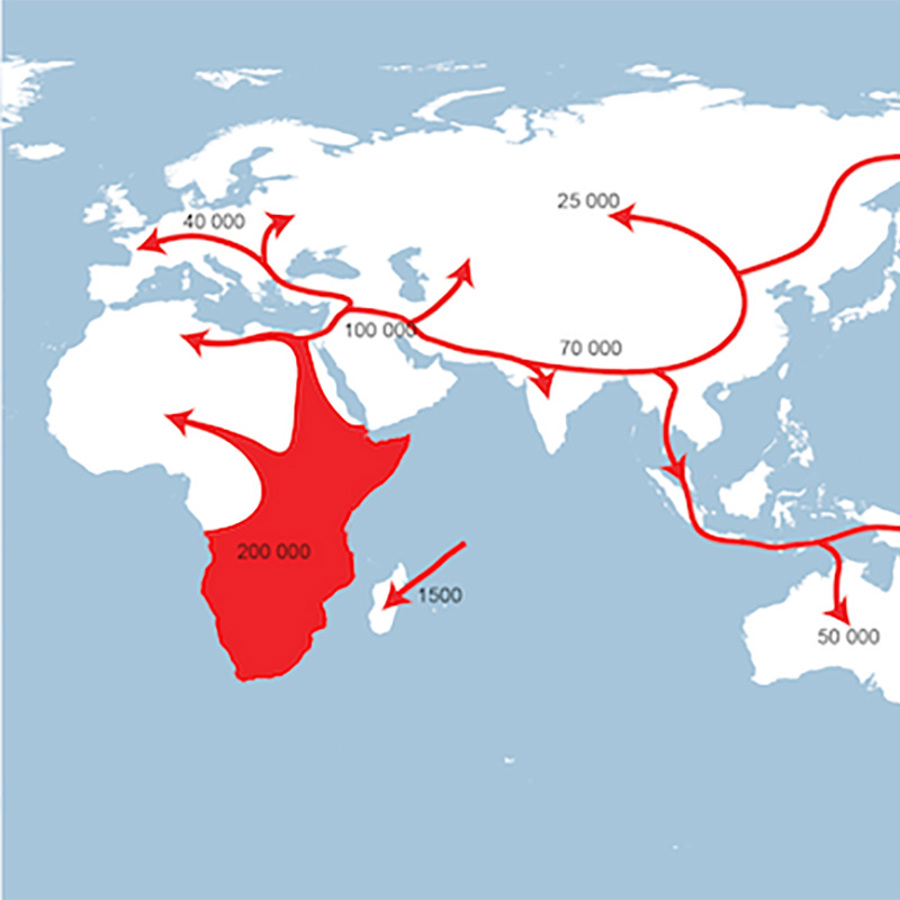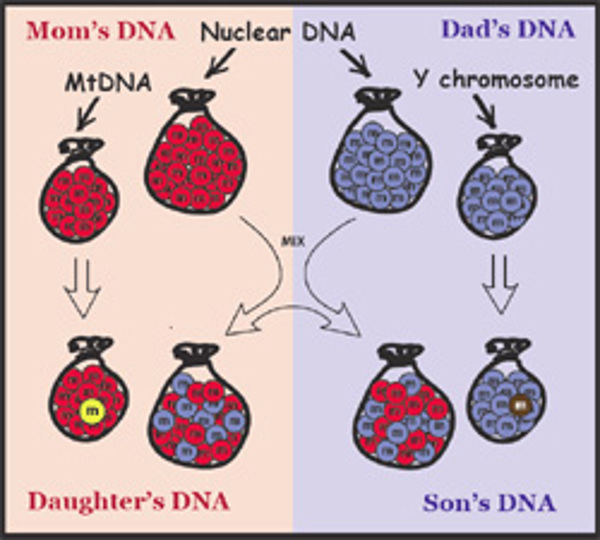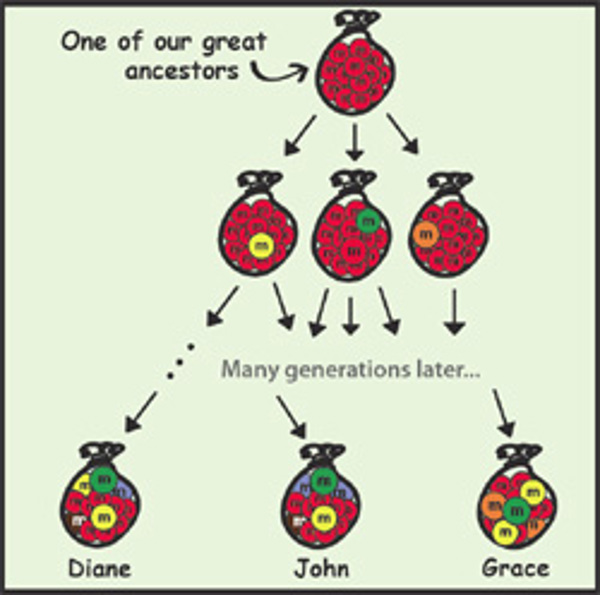
How can some scientists determine that all humans were originally from Africa?
November 23, 2010

- Related Topics:
- Y chromosome,
- Human evolution,
- Mitochondria,
- Evolution
A middle school student from Michigan asks:
“How can some scientists determine that all humans were originally from Africa?”
Great question! Scientists have believed for quite some time now that we all came from Africa. They first thought this might be true because all the old human fossils they found were from Africa.
But this isn’t as strong of evidence as you might think. See, fossils are both rare and fragile. It could just be that conditions were perfect in Africa for fossils while bad weather in Europe and Asia destroyed all the fossils there.
The best evidence for our African-origins actually comes from looking at our DNA. African DNA varies a lot more than European, Asian, or Native American DNA. In other words, two Africans usually have more DNA differences from each other than do two Asians, two Europeans, or two Native Americans.
Why is this observation useful? Well, DNA is not as constant as you might think. It changes a bit generation after generation and it changes at more or less the same rate. So the group that was around the longest would have the most variety of DNA. That group would be Africans.
Second, a good hard look showed that all the non-African DNA is very similar to one group of African DNA. In other words, all other DNA came from African DNA.
What I want to do for the rest of the answer is show you how scientists figured this all out. As you’ll see, they had to ignore almost all of our DNA and focus on just a small bit of it. Despite how small that little bit is, it can tell us an awful lot about our history.

Most of Our DNA Gets Mixed Up when it is Passed On
If you’ve been reading the answers to some of our other Ask a Geneticist questions you know that DNA is the cookbook of life. It has all the genes, or recipes, for making you who you are.
DNA is inside nearly every cell in your body and you get half of it from your mom and half from your dad. Most of the DNA inside your cells is contained in a little sac called the nucleus.
Before it is passed on to the next generation, the DNA from your mom and your dad mixes. While this doesn’t affect you, it will affect your children.
Imagine it like getting two bags of M&Ms, a bag of red ones from your mom and a bag of blue ones from your dad. You mix the M&Ms together inside one bag, kind of like how DNA from your mom and your dad mixes before it is passed on. You then split your M&Ms into two bags without picking colors, and give one bag to someone else. This is your sibling. Let’s call him Barry.

So Barry has a bag of red and blue M&Ms. Let’s say that he mixed this bag with another bag of yellow M&Ms. He then split it in half just like you did, and passed it on to another one of his friends. After a few times of mixing and separating, it would be really hard to figure out where a mixed bag of M&Ms came from.
In the same way, the DNA inside the nucleus of your cells mixes and changes so much from generation to generation that it is very tricky for scientists to track. In fact, after about five generations, it is nearly impossible to say which bit came from whom.
Scientists today believe that humans left Africa 50,000-100,000 years ago1. However, this is obviously much more than five generations. So how did scientists track DNA back so far?
By concentrating on the two bits of DNA that don’t mix.
Only a Bit of Our DNA is Helpful
Not all of our DNA gets mixed up. Some of it passes from generation to generation virtually unchanged.
One piece of DNA that doesn’t get mixed is called the Y chromosome. Most people with a Y chromosome are male. So the Y chromosome gets passed on through the male line, from Grandfather to Father to Son, and so on.
The Y chromosome is like a separate bag of a few M&Ms that don't mix. This small bag gets passed from father to son through time.
Another piece of DNA that doesn’t mix isn’t even in the nucleus! It is in another part of your cells, called the mitochondria. What’s cool about the mitochondrial DNA (mtDNA) is that all of it comes from your mom and none comes from your dad.
Since you don’t get any mtDNA from your dad, this means that there is no mixing between your mom and your dad’s mtDNA. It is like another little separate bag of M&Ms that doesn’t get mixed in with the others.
You get all of your mtDNA unmixed from your mom, and she gets all of hers from her mom. This means that you have your maternal grandmother’s (and maternal great-grandmother’s) mtDNA!
Scientists can use mtDNA and the Y chromosome to trace back where we came from. For example, if I knew that a woman in Africa had the exact same mtDNA as mine, then I would know that she is my ancestor.
But it’s not as simple as that. Scientists have no way of finding DNA from every person who lived millions of years ago. So we have to use another trick based on the fact that our DNA changes a bit from generation to generation.
DNA is not Written in Stone
DNA changes a bit from generation to generation. Most of these changes are very small and don’t really affect us in any way. However, they are very useful to scientists.
These small changes happen in a couple of different ways. One way is because of DNA damage. Something in the environment like sunlight or cigarette smoke mutates the DNA, changing it.
Another way is that our own cells change our DNA! Every time a cell divides, it needs to copy all of its DNA. On average, every 1000 divisions or so our cells make a mistake. If that mistake happens in an egg or a sperm, it is passed down to the next generation.
Scientists can use these changes to track how related any two people are. They can do this because they know about how often DNA changes happen. By comparing two people’s DNA, they can get a rough idea about how many generations ago two people shared an ancestor.
To understand this better, let’s imagine DNA as a bag of M&Ms again. We’ll focus on the mtDNA (although it works for the Y chromosome too).
Remember that we get our mtDNA exactly as is from our mothers. Imagine it is a small bag of red M&Ms separate from the big bag of nuclear-DNA M&Ms.
Moms will pass this little bag of red M&Ms to their children. And her daughters will pass it down to theirs. And so on. There won’t be any mixing, so everyone who had mom as an ancestor will have a little bag of red M&Ms.
But remember this is too simple. There are occasional small changes in this mtDNA as it is passed down. To model these small changes, let’s imagine that we pick out one M&M from our bag every few generations and replace it with a different colored one. After a while, a bag of red M&Ms that gets passed around will have mostly red M&Ms but will have a few other colors too.
Now imagine that instead of passing on one bag of M&Ms, you could pass on two or three to different people. This is like when a woman or man has more than one child – they pass their DNA on to each child.
Now each of these people passes on their bags with the occasional small changes. After awhile you have lots of bags with mostly red M&Ms and a few different colored ones.
Let’s say one day I met a boy named John. He has a bag of mostly red M&Ms too with a few other colors that are not the same as mine.
I could guess that we likely got the same bag of red M&Ms at some point and the few differences between our bags were due to random replacements made as the bags were passed along. So John and I might be distant cousins!

Next I meet Grace who has a lot of M&Ms that are different than the ones I have, but still mostly red. I could probably guess that we share an ancestor, but that our bags have been passed down a lot more times. Hence, the shared ancestor of Grace and me would be much older than the one of John and me.
And that’s it! That’s the idea that scientists used to figure out where humans came from!
After looking at the mtDNA and Y chromosome sequences of modern-day people from all over the world, scientists realized that people from Africa had the most differences in their DNA from each other. In contrast, people from North America, for example, had DNA that was much more similar. This means that the shared ancestor of all Africans is older than the shared ancestor of all non-Africans. So the first humans must have been African.
What's more is that if you look at all the DNA from non-Africans around the world, you would find that they are all very similar to the DNA from one small group of Africans. This is what makes us think that humans from all over the world originated from this group of Africans.
Using this evidence and some assumptions about the average time to reproduce, scientists estimate that humans probably migrated out of Africa some 50,000 years ago.1

Author: Diane Wu
When this answer was published in 2010, Diane was a Ph.D. candidate in the Department of Genetics, studying post-transcriptional gene regulation in Andy Fire's laboratory. Diane wrote this answer while participating in the Stanford at The Tech program.
 Skip Navigation
Skip Navigation
